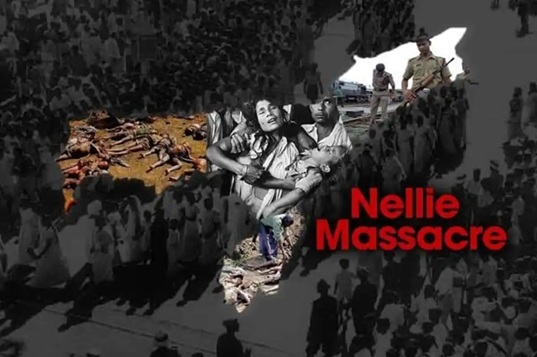(Preliminary Examination: History of India, Current Affairs)
(Mains Examination, General Studies Paper 1: Modern Indian History from the mid-18th century to the present day—Important Events, Themes; Salient Features of Indian Society) |
Context
The Assam government has decided to present the investigation report of the 1983 Nellie Massacre in the upcoming Assembly session in November.

About the Nellie Massacre
- The Nellie Massacre is one of the worst communal massacres in India since independence.
- It occurred on February 18, 1983, in Nellie and surrounding villages in the Nagaon (now Nagaon) district of Assam.
- The incident occurred at the height of the Assam Movement, when widespread protests were underway in the state against "foreign nationals," i.e., Bangladeshi Muslims.
Historical Events
- On February 18, 1983, on the day of the assembly elections, a mob attacked local Muslim villagers.
- This violence allegedly targeted non-Assamese (mainly of Bangladeshi origin) voters.
- According to various reports, more than 2,000 people were killed. However, non-governmental estimates put the number at 3,000 to 5,000.
- Most of the victims were women and children.
- Bodies were dumped in rivers and fields, and the process of relief and justice was virtually nonexistent.
Inquiry Commission
- The then Assam government constituted a commission headed by Justice Tribhuvan Prasad Tiwari to investigate the massacre.
- The Commission's objectives were:
- To investigate the causes of the violence
- To identify administrative and political failures
- To suggest measures to prevent such incidents in the future
- The Commission submitted its report to the government in 1984, but it was never presented in the Legislative Assembly because the Commission Chairman's signature was missing on the copy of the report.
Significance of the Report's Presentation
- Chief Minister Himanta Biswa Sarma has announced that the report will now be tabled in the Legislative Assembly, providing the public with official information about the events and findings of that time.
- This move is being considered an effort towards historical justice and transparency.
- Making the report public will clarify where the administrative structure and political decisions fell short and how such tragedies can be prevented in the future.
Conclusion
The Nellie Massacre is a profound stain on the democratic history of not only Assam but also India. The presentation of the report after four decades is an opportunity to reassess historical truth and collective memory. This will not only help in understanding the tragedy of the past but will also pave the way for strengthening goodwill and justice in the future.



